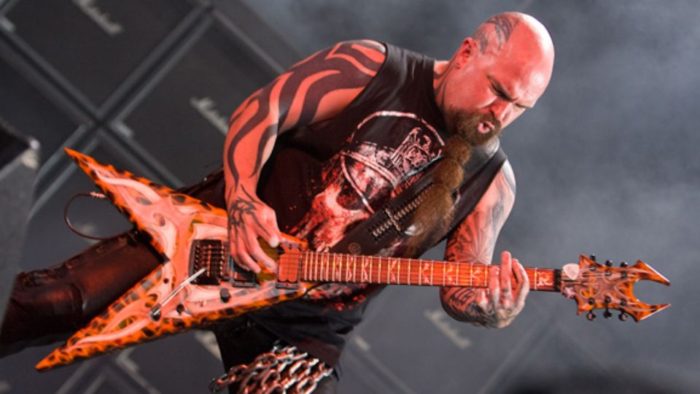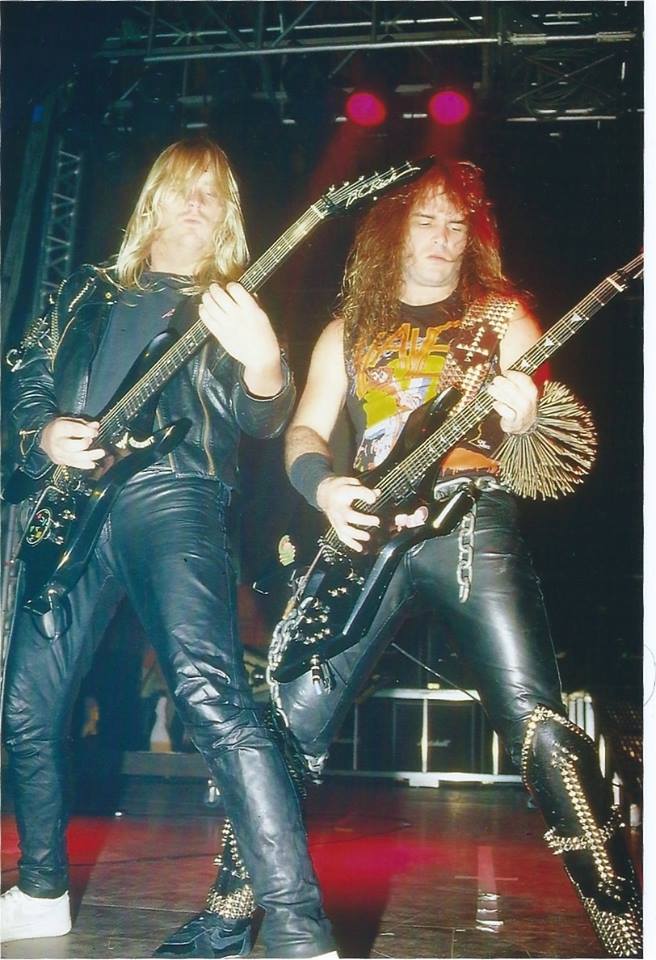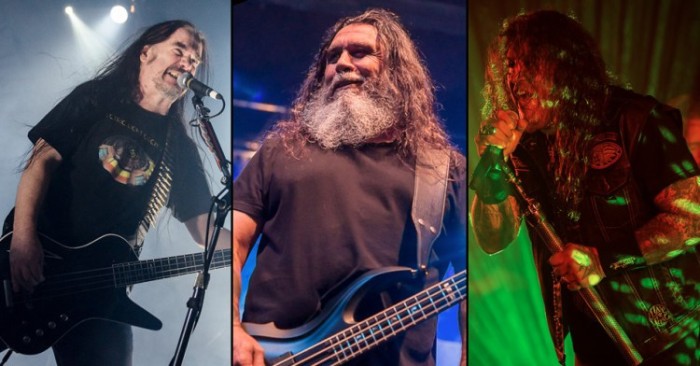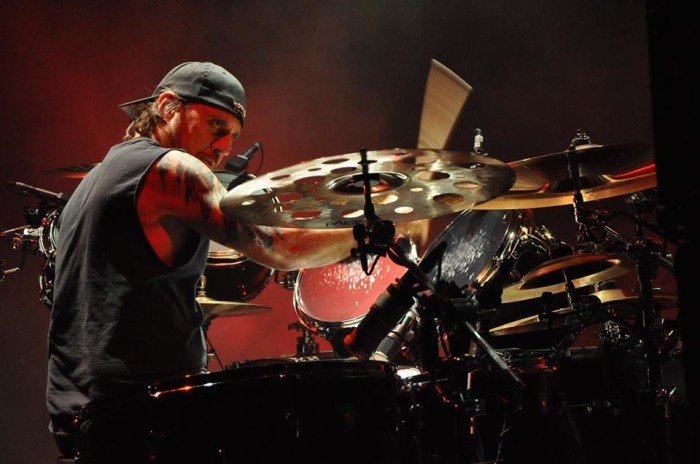Death Metal Underground has obtained an Agoraphobic Nosebleed cover of Slayer‘s classic “Angel of Death“.
7 CommentsTags: Agoraphobic Nosebleed, Angel of Death, core, cover songs, drugs, hipster bullshit, metalgate, news, sjw metal, slayer
Death Metal Underground has obtained an Agoraphobic Nosebleed cover of Slayer‘s classic “Angel of Death“.
7 CommentsTags: Agoraphobic Nosebleed, Angel of Death, core, cover songs, drugs, hipster bullshit, metalgate, news, sjw metal, slayer
Dave Lombardo has joined Suicidal Tendencies for their European Tour and upcoming album to be released in September 2016.
3 CommentsTags: Crossover, crossover thrash, dave lombardo, news, slayer, suicidal tendencies, Thrash, thrash metal

Slayer are touring North America this fall with lesser eighties speed metal bands Death Angel and Anthrax. I’m still hoping for a SlayExodus tour where the same lineup plays 75% Slayer and 25% Exodux material. Slayer Fan Club members (Does anyone who doesn’t watch the WWF pay to join this?) may preorder tickets now; sales to the general public go on sale Friday.
4 CommentsKerry King: “It’s always super fun for us to tour with Anthrax. Frank is one of my best friends in the biz!! Put that together with Death Angel, and fans will probably see the best package this year. See you there!”
With more dates to be announced, here is the confirmed itinerary:
SEPTEMBER
9 Jacob’s Pavilion, Cleveland, OH
10 Freedom Hill Amphitheatre, Detroit, MI
12 Sound Academy, Toronto, ON
13 Metropolis, Montreal, QC
15 Stage AE, Pittsburgh, PA
17/18 Rock Allegiance, Chester, PA*
20 Egyptian Room, Indianapolis, IN
22 The Pageant, St. Louis, MO
27 Hard Rock Live, Orlando, FL
28 Fillmore, Miami, FL
30 Horseshoe Casino Tunica, Tunica, MSOCTOBER
3 Norva, Norfolk, VA
5 Tabernacle, Atlanta, GA
7 Gas Monkey Live, Dallas, TX
8 ACL at the Moody Theatre, Austin, TX
10 Fillmore, Denver, CO
11 The Complex, Salt Lake City, UT
13 The Wilma Theatre, Missoula, MT
17 ENMAX Center, Lethbridge, AB
19 South Okanagan Events Centre, Penticton, BC
20 Abbotsford Centre, Abbotsford, BC
23 Reno Events Center, Reno, NV
27 El Paso County Coliseum, El Paso, TX* Slayer, Anthrax and Death Angel are all on this bill.
Tags: anthrax, death angel, news, slayer, tour, tour dates, US tour

Article by Lance Viggiano
Metal, like nearly every form of contemporary western music, carries legacy traits from western classical music. Noting these inherited qualities and their contribution to metal’s identity is a fruitful venture worth study. Yes, some artists such as Emperor created music that may as well have been performed by an orchestra. Nevertheless there is a distinct tendency among metalheads to validate metal through this heritage. The logic behind this is eloquent and simple: Classical maintains an esteemed position and metal retains compositional/artistic characteristics of classical; therefore metal is good (insert adjective for good: High Art, Quality, etc.). This does a disservice to metal however as it forsakes the baroque for the succinct while deriving much of its power from textural aesthetics. Metal needs to be qualified and judged according to its own merits.
Both forms of music arrange motifs according to an underlying narrative. The pathos of western classical music is derived out of experiments in harmony that attempted to imitate a well ordered and intricately planned cosmos. The composer embodies the role of the One God who conceives and executes a nature in which each of its parts cooperate in accordance with divine law or in the case of music: its score and story. Metal however is all about the riff; not just its position in the score but also the way it sounds and the way it feels. Downtuning a guitar, plugging it into a bass amp, and dialing the gain knob to its upper limit are not trivial or accidental decisions. The textural component gives the music body which allows for succinct motifs to achieve significance out of relative simplicity. On the other hand, classical must take on a ”notey” characteristic to give the music weight. The roar of an ensemble is a force of its own, yet it is comparatively tame next to the bludgeoning delivered by an amplifier and a few pedals.
Classical entices the mind with intricate and ornate patterns while metal ignites the heart by delivering an unabashedly barbaric, vitriolic and brash force of will. With each occupying distinct but equally valid dimensions of the human experience – The mind and the heart, respectively – it becomes clear that using one to validate the other does a great disservice to each form of music. Unplug metal and survey its patterns next to classical and one will find that it sounds as if it was composed by intellectually immature children. Plug classical patterns into metal and one finds that the need to make tonal sacrifices to retain clarity while distilling patterns down so as to be performed by fewer instruments results in sterile powerless wank which exists without proper support.
The Romantic movement turned its gaze back to the primacy of nature from the perspective of the civilized man who took all of his habits of thought with him; retaining his clear, distinct abstract patterns and hard mental boundaries. He walks at a distance from the forest so as to keep his boots from the blemishing mud and his coat from the shearing thicket. The Romanticism of metal walks barefooted against the cold soil, barely managing to escape the weather but never the bonds of nature. His damp stone refuge is aerated by a primate musk so thick that the festering gobbets and searing tendons of his kill cannot penetrate it. The civilized man understands nature as an idea from which he is blissful detached and divinely endowed to understand while the uncivilized man understands nature as an irrational outpouring of desire against which his only freedom is attained by projecting his own will against the world. Each vantage point offers a unique view of the same landscape. From that summit the artistry of metal ought to be discussed and ultimately, loved.
37 CommentsTags: article, beherit, black sabbath, Classical, classical music, composition, Dismember, emperor, Heavy Metal, metal, Philosophy, Romanticism, slayer

The folks at Loudwire recently conducted an interview with Tom Araya. In it, Araya talks about a great swathe of topics relating to his career with Slayer; what particularly stood out to me was his discussion of what went into Repentless. While we’ve probably reiterated more than enough that Repentless wasn’t very good, it’s still interesting reading about the differences Araya perceives between it and previous albums. There’s also some bits of interesting trivia in there that I personally wasn’t aware of before; such as Araya’s affinity for ’70s rock and the Beach Boys, and the varying work ethics and styles of various bandmembers past and present.
No CommentsTags: interview, loudwire, Repentless, slayer, tom araya
Did you ever wonder where you could get those cool stickers that say “Employees Must Carve Slayer Into Their Forearms Before Returning to Work”? What about a Satanic, sleazy, anarchist and cynical mockery of American pop culture and Hollywood Entertainment? Shane Bugbee, who formerly threw metal festivals long before it was cool and now produces pop-art-satire, is selling these through his online shop. If you want to see Mickey Mouse as a Misfits skull or a Laveyan take on the Goonies, this is the place also. Shane sent over a raft of stickers, pins and buttons for us to check out at DMU HQ and we’ve enjoyed spreading these around to those who know how righteously these mock mainstream culture. The Slayer sticker is going in the corporate washroom however.
5 CommentsTags: employees must carve slayer into their forearms before returning to work, Heavy Metal, merchandise, shane bugbee, slayer, stickers

A veritable tour of the fallen? Perhaps. Blabbermouth recently blabbed about these bands going on a tour of the US some time in 2016. According to them, a March 3rd performance at the Fillmore in Philadelphia has leaked, but little else has been officially revealed. If this does turn out to be an actual tour, and not just an attempt by record labels to entrap some sort of leak at Blabbermouth, it’s… probably worth noting, but far from the best lineup you’re going to see. Slayer and Carcass, at the very least, have strong legacies under their belts (although recent works fail to live up to such), but Testament’s career has been iffy at best, despite some musically proficient if not particularly inspired speed metal at the beginning of their career. As usual, it’s up to you, the reader, to determine whether this concert is worth your time.
Editor’s note: The tour was later confirmed. As of December 3rd, here are the dates:
2/19 – Riviera Theatre, Chicago, IL
2/22 – War Memorial, Nashville, TN
2/24 – The National, Richmond, VA
2/26 – House of Blues, Myrtle Beach, SC
2/27 – The Ritz, Raleigh, NC
2/29 – The Fillmore, Charlotte, NC
3/2 – Capitol Theatre, Port Chester, NY
3/3 – The Fillmore, Philadelphia, PA
3/5 – The Fillmore, Silver Spring, MD
3/6 – The House of Blues, Boston, MA
3/8 – LC Pavilion, Columbus, OH
3/9 – The Orpheum, Madison, WI
3/11 – Myth, St. Paul, MN
3/12 – Civic Auditorium, Fargo, ND
3/14 – MacEwan Hall, Calgary, AB
3/15 – Shaw Centre, Edmonton, AB
3/17 – Revolution Event Center, Boise, ID
3/19 – The Paramount, Seattle, WA
3/20 – Roseland Ballroom, Portland, OR
3/22 – Warfield Theatre, San Francisco, CA
3/26 – The Joint, Las Vegas, NV
Tags: 2016, carcass, mainstream metal, slayer, testament, tour dates

In other news that beats trying to explain why My Dying Bride’s latest LP is a borehole and a psychic drain (more on that later today if all goes well), Dave Lombardo of Slayer fame has started a hardcore punk band, adding to his already substantial roster of projects. Besides Lombardo, Dead Cross also features Justin Pearson from The Locust and Retox. If the band’s lineup and announcement on Vice are any indication, Dead Cross may take more after modern hardcore punk and metalcore than older substyles of the genre. If you particularly need to hear members of Slayer performing classic hardcore punk, there’s always Slayer’s Undisputed Attitude, although Lombardo was out of the band when it came out in 1996.
Tags: dave lombardo, dead cross, Hardcore Punk, slayer, undisputed attitude

The title probably needs a few instances of “again” sprinkled throughout, but whatever. Metal Blade is presumably in the very early stages of putting out new vinyl presses of early Slayer recordings, as evidenced by their decision to announce this through one of our competitors. This rerelease focuses on Slayer’s earliest releases – their first two studio albums, as well as the Live Undead and Haunting the Chapel EPs. Like many of these vinyl reprints, it seems to be fairly limited in scale – only about 1200-1500 of each album is going to be pressed, and any collector who misses these is going to have to wait for a new pressing or content themselves with one of the many older versions. The actual musical content of these records is worth your time, anyways, which is something you can’t say about every record released.
Tags: haunting the chapel, hell awaits, live undead, metal blade records, show no mercy, slayer, vinyl
Only one can lead: guitars, voice, bass or drums. Whatever takes the lead will compel others to follow because lead means sketching out the structure of the song. The classic metal albums all lead with guitars and vocals catch up while drums provide accents and bass does whatever it feels necessary.
Repentless reverses this formula. It is built around Tom Araya’s mostly fast-spoken or chanted vocals, and guitar keeps up and drums frame the whole thing. The bass doubles the low notes and does little else, but Slayer has always used that technique. The problem is that in a desire to make catchy choruses and compelling verses, Slayer has relegated its most powerful aspect — the lead rhythm guitar — to a supporting role.
Despite a number of good riffs that call to mind material from the Seasons in the Abyss era, on this album Slayer has had to contort itself to fit around the vocals like a rock song, which de-emphasizes guitar and consequently cramps it and, in its reduced role, forces it to show off and simultaneously keep itself restrained. This keeps the worst of metal guitar and throws out the best. In addition, this reduces songs to minimal song structure based more around a lyrical narrative (or topic of a video) than development of melodies or patterns in the riffs.
This is far from a bad album. The problem is that it is the wrong sort of album. Metal escaped from rock by minimizing the human, especially vocals and feelings, to create a gritty realistic confrontation with the nihilism of existence — the knowledge that events do not depend on feelings or mythological beings, but cause and effect. Slayer expanded its audience in the 1990s to the present by being more centered on vocal hooks and foot-tapping rhythms, and does well at this, but at the expense of what made this band great.
12 CommentsTags: death metal, Heavy Metal, Repentless, rock music, slayer, Speed Metal